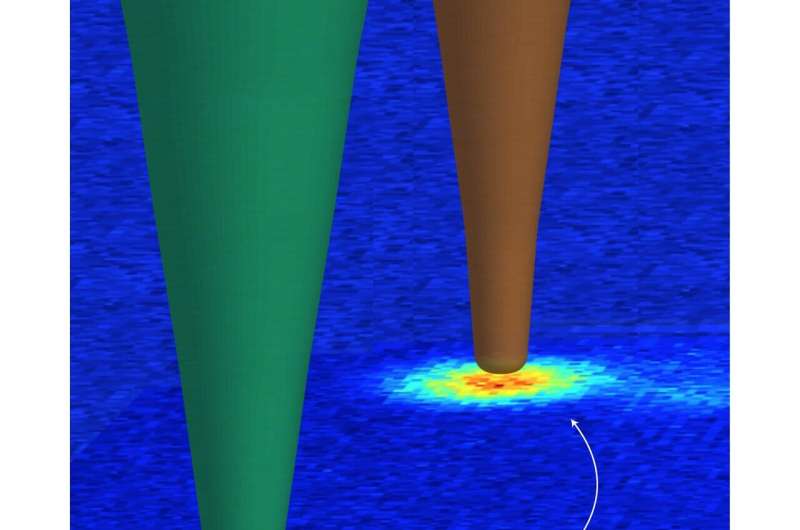November 5, 2021 feature
Researchers induce and detect charge transport between color centers in diamond

Color centers are atomic imperfections in crystalline solids that absorb visible light of a particular color or radiation. These defects, typically in the form of missing atoms or substitutional impurities, can produce a characteristic color in materials that are generally transparent.
The understanding of how color centers in semiconductors capture charge carriers could facilitate the development of new sensing and quantum devices. However, experiments aimed at investigating color centers often require large collections of defects whose mutual proximity and uncontrolled interaction can have unanticipated effects on the observations.
Researchers at City College of New York (CUNY), Sandia National Laboratories, the Flatiron Institute, and the Australian National University (ANU) have recently carried out a study investigating nitrogen-vacancy (NV) centers, renowned color centers in diamond. Their paper, published in Nature Electronics, demonstrates the optical activation and detection of charge transport between different NV defects in diamond.
"A couple years ago, we had a crude idea, namely, we knew that NV centers can be optically spin polarized and we also knew that their charge state can be controlled with optical pulses," Carlos A. Meriles, one of the researchers who carried out the study, told TechXplore. "So, we imagined that these two ingredients could be combined to inject spin polarized charge carriers in diamond (as it turns out, diamond is a nearly ideal material for spintronics applications that, so far, remains unexplored, precisely because of difficulties in spin injection)."
Meriles discussed the idea with Marcus Doherty at ANU and they started thinking of charge carriers in a different way. More specifically, they started considering them as a 'bus' that can coherently transport quantum information between color centers.
In 2016, Meriles, Doherty and other researchers published a theoretical paper that formalized this idea. Subsequently, they conducted a series of studies aimed at implementing it in an experimental setting. Their recent study brings these ideas one step closer to reality.
"Since diamond is a transparent material (i.e., it does not absorb visible light), one can think of NV centers (and other 'color centers') as virtual atoms trapped in a somewhat 'inert' environment created by the surrounding solid," Meriles said. "As such, the system energies are quantized and one can use light to excite it between different levels."
If researchers excite diamond or other transparent materials with a sufficiently strong laser, a second photon can arrive before the previously excited NV center had time to relax. This process can cause the NV to emit an electron, if it originally had an excess negative charge, or a hole, if it was initially in a neutral state.
In their experiments, the team successfully induced this process in diamond at room temperature using two techniques, namely confocal fluorescence microscopy and magnetic resonance. Confocal fluorescence microscopy is a microscopic imaging technique that allows scientists to observe samples with a high 3D optical resolution, while magnetic resonance is a renowned imaging method that entails exposing samples to magnetic fields.
"If one was to use typical literature values to calculate the probability of capturing a charge carrier from an atomic source a couple microns away, one would find that chances are comparable to winning the lottery," said Artur Lozovoi, a postdoctoral fellow in Meriles' research group and lead author of the study. "So, the very observation of the process was, in itself, very surprising."
In their paper, the team suggests that their observations could be explained by the intermediate formation of so-called "Rydberg states." Rydberg states are quantum states observed in molecules or atoms, where a particle's orbits resemble those of a hydrogen atom and are very large.
"If this is indeed the case, it could perhaps be possible to recreate in the solid state what atomic physicists produce in vacuum, i.e., an array of color centers whose quantum states are sufficiently large so that they can interact with each other," Meriles said. "I emphasize, however, that this is only hypothetical at this point in time."
In the future, the strategy for activating and detecting charge transport between NV centers introduced by this team of researchers could pave the way for more studies focusing on color centers and how they capture charge carriers. In addition, the team plans to conduct further experiments aimed at implementing and examining the same strategy at different temperatures.
"While these experiments took place under ambient conditions, we are now adapting our setup so that we can work at low temperatures where, we think, we may witness a different regime (with charge carriers propagating 'ballistically' rather than 'diffusively')," Lozovoi added. "If so, we might find opportunities for guiding carriers more efficiently from one NV to the other (to gradually transition from a 'probabilistic' to a nearly 'deterministic' transport process). In our next studies, we also intend to better understand spin related processes at these temperatures as well as the impact of externally applied magnetic fields."
More information:
Artur Lozovoi et al, Optical activation and detection of charge transport between individual colour centres in diamond. Nature Electronics(2021). DOI: 10.1038/s41928-021-00656-z
www.nature.com/articles/s41928-021-00656-z
M. W. Doherty et al, Towards a Room-Temperature Spin Quantum Bus in Diamond via Electron Photoionization, Transport, and Capture, Physical Review X (2016). DOI: 10.1103/PhysRevX.6.041035
© 2021 Science X Network



















